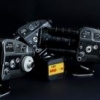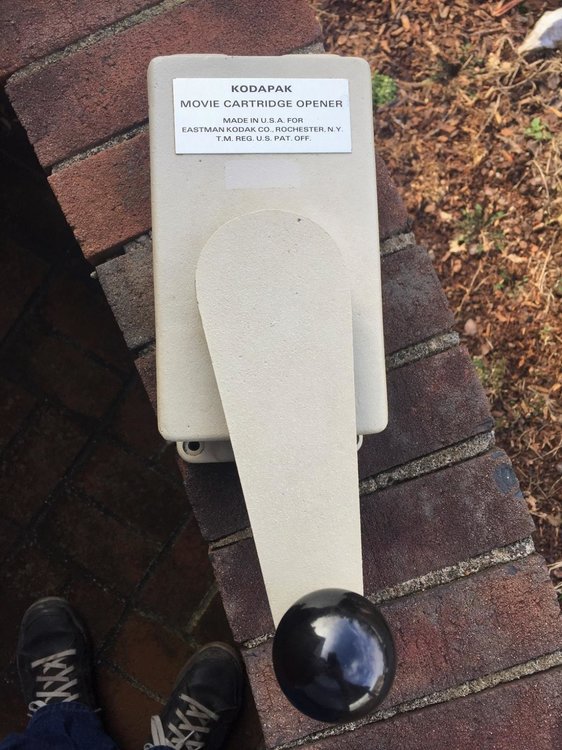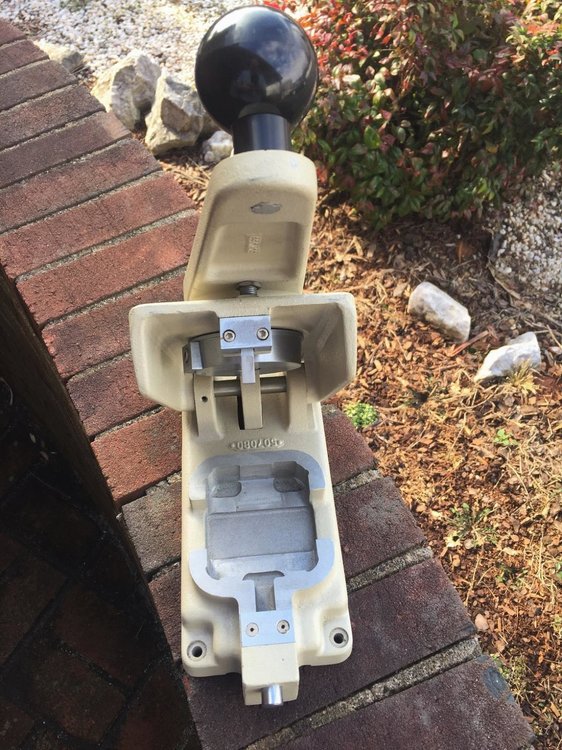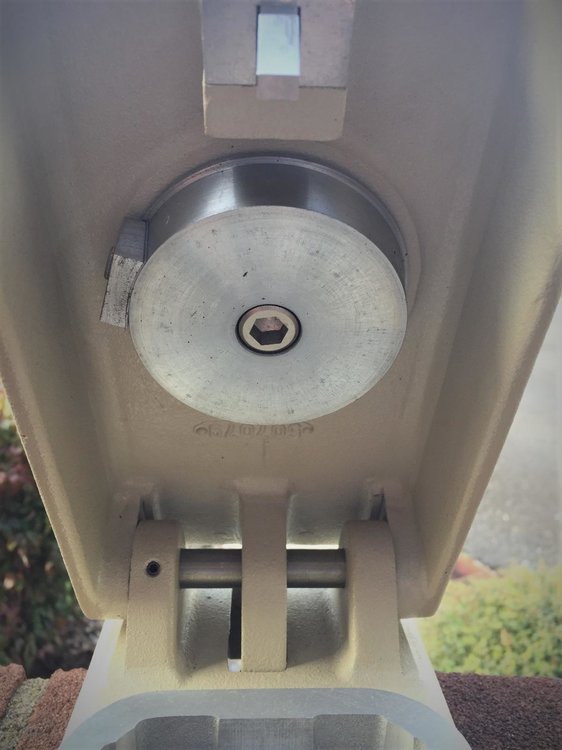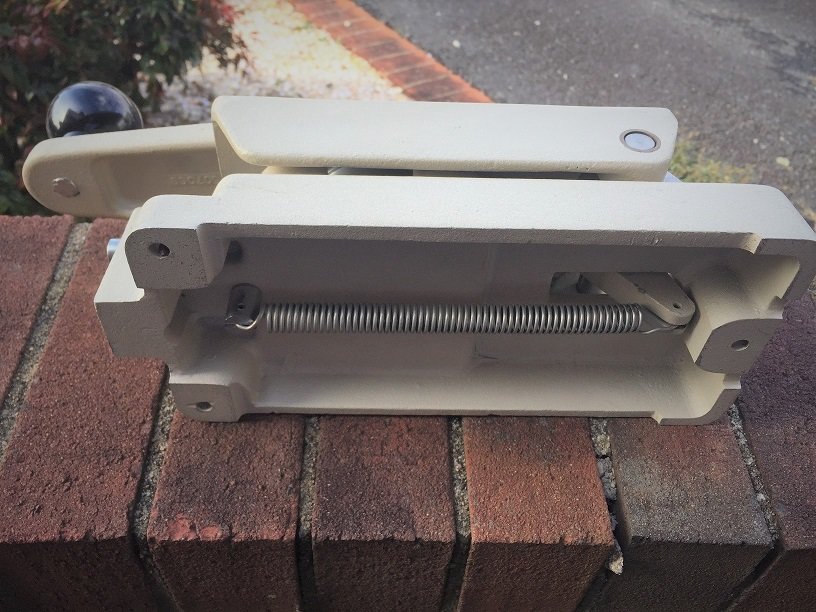Search the Community
Showing results for tags 'DIY'.
-
This is sort of a continuation of this thread, but it's 16mm so I wanted to post it here. I'd previously built myself a super 8 scanner using a firewire machine vision camera, an arduino, a stepper motor, and an old projector. I'd been meaning to scale it up to 16mm for a while and finally got around to doing it. It took a few hours of tinkering, but here's my first test footage! The source material is obviously not mine, it's from an old Castle Films "Chimp the Sailor" that I had lying around. This is literally the first thing I've scanned so far, I JUST got it working, so it's not perfect. But not bad for a first try on a very very sub $500 setup, right? Comments/questions are of course are welcomed!
- 19 replies
-
- 1
-

-
- StepCapture16
- DIY
-
(and 1 more)
Tagged with:
-
Hello, Good People! I’m a one-man band, DIY type filmmaker and frequently find myself acting as my own cinematographer (and literally everything else unfortunately). I have great respect for the craft and would love to improve my skills until I can afford a proper professional to do the job. I’ve been shooting my own stuff forever and feel like I’ve lost perspective. Nice images aren’t enough and I need to work on my shot choices and motivation. People were very kind about it on reddit and I'm just looking for some different perspectives. I made this short (starring my mom) for a competition. I used the one LED panel I had to fill in some spots, but 95% was shot with DIY practicals ( loose light bulbs, mobile phones, etc...) and a whole lot of duct tape to keep them in place! ? Any tips or feedback would be tremendously appreciated! Thanks again! Here's the short: P. S. This was shot on the BMPCC4K with a 50mm f1.2 SLR Magic lens.
- 1 reply
-
- 1
-

-
- novice
- middle east
-
(and 1 more)
Tagged with:
-
Hi everyone, I recently got back into analog photography and (re-)discovered with interest that some of the motion picture films are used by certain photographers and even home-processed (Kodak Vision 3 series seems appreciated). As a not-complete-beginner in home-processing for stills (mainly B&W to be honest), I see some opportunities for me discover new horizons by doing the same for S8. Apart from the obvious question of appropriate hardware and chemicals (Internet is my friend), I was wondering if some of you guys have experience with home-processing S8 and what is your take on this ? Are the results worth it ? Does it open some new creative opportunities for you ? Do you process your negative color stocks in C-41 or ECN-2 ? ... Also related to processing, I was wondering how does S8 handle pushing / pulling. To be honest I always shot S8 at box speed because of the extra costs involved when pushing/pulling film in most regular labs. Up to now I've always shot daylight and outdoors but I came across situations where the max box speed available in my bag was not enough to get proper exposure (overcast days in the woods for example), maybe pushing the films could have saved the day ... I assume negative stocks are better mediums for pushing/pulling ; do you have experience in pushed/pulled S8 stocks ? What were the outcomes ? Thanks for your insights and experience.
- 4 replies
-
- super-8
- processing
-
(and 2 more)
Tagged with:
-
I became interested in microcontrollers a while ago and I am considering a DIY sync sound motor for my Kinor 2m camera. I also have other cameras which could use a stable speed motor (for example my 35mm Soyuz-US3N camera and the rheostat motored Konvas 1KCP. This is because there is no available motors of any kind for Soyuz and the rheostat Konvas never had any sync motors made originally) . I started with the 16mm Kinor motor last month and I'm refining the analog control electronics and fine tuning the code now. I was just thinking, is there lots of people out there who could use a customisable sync sound motor on their camera and if so, which exact camera models would be the most in demand? If there seems to be some common interests then I could take them into account when developing my own motor project and it might be easy to make custom solutions for other persons cameras as well. --------- What would be the absolutely mandatory specifications for this type of motor? I am aiming for +/- 10rpm accuracy at the moment but we will see how accurate the diy solution will be when it is fine tuned for the specific motor and camera model. That 10rpm accuracy would be about 1 frame drift for every 2.5 minutes of footage shot which should be usable for sync sound uses in indie films which have relatively short takes (a minute per take for example). My current design for the Kinor16 motor will have 6 different preset speeds and it uses the original pilot tone generator just like the Olex crystal sync modification does though my design is not as sophisticated or accurate (one gets what one pays for :) the Olex motor is better and my design is cheaper). - what type of camera and "wild" motor would most urgently need a digital speed stabilising system like this one? - how accurate the speed needs to be. how much it can drift to be usable? I am talking about minimum specs which would enable practical use of the system, NOT about how much would be nice to have :) - how much it can cost, in case there seems to be so much demand that it would be doable to do for example a dozen or so of these? - how much the end user can assemble by themselves? is a parts kit with pre drilled circuit board enough (needs soldering and a little bit of tuning) or only fully assembled board would do? - it is very clear from beginning that this type of product needs to be user installed to be a viable option. It would not be economical to ship cameras and motors back and forth between continents, that would ruin the whole point of this type of motor solution - what kind of inputs for the encoder which is attached to the motor. My current design uses the pilot tone generator signal coming from the Kinor motor but for other cameras I will use either a encoder disc or magnetic sensors for rpm feedback.
-
These are exceeding rare laboratory grade Super 8mm film cartridge opening machines! If you've ever tried to open a Super 8mm Cartridge gently when processing your own, you know what an ordeal it can be! If you have a dozen or more to open, it can be torture on you and possibly your film. This machine, which is about 10 lbs of cast aluminum, has a razor sharp blade on a circular bit under the cover. Place the Super 8mm cartridge in the aperture, close the lid, give it one revolution on the handle and you have a perfectly cut circle in the side of the cartridge to gently extract your film! Fantastic shape! Almost like new! $250 USD (willing to entertain offers as well) to me via Paypal or USPS Money Order + actual shipping cost to you. Made by Kodak for Kodak Super 8mm cartridges; what more can you ask for? Thanks for looking!
-
I'm shooting a music video inside a restaurant with drop ceiling (location) and would like to create practical overhead lighting (like this) to give us more freedom with our framing. In the example above -- it looks like they popped out tiles where they needed light, laid out a large cut of diffusion across several tiles and placed individual fluorescent tubes (astera, quasar or kino?) on each rectangle. What do you think? Can anyone provide any helpful ideas on how to achieve lighting like this on a modest budget? The restaurant also has several 3-bank T12 fluorescent fixtures already installed. I'd like to replace these fixtures with T12 kino tubes but the location is pretty dated and I'm worried about flickering because of old ballasts. How can I tell if the ballast will produce a flicker? I looked around the fixture and didn't find any specs printed on the side.
- 5 replies
-
- drop ceiling
- drop
- (and 14 more)
-
Hello, Was wondering if any of you ever used a Skypanel S60 with an Anton bauer Cine VCLX block battery? I know battery voltage of Cine VCLX has max 28v (3pin XLR) which reduces light output from S60. My question is mainly regarding cabling in order to power the Skypanel on this type of battery. Arri don't seem to have/sell a cable or adapter from Battery input on the head 23-36V DC (4 pin XLR) to 28V (3 pin XLR) output on the Cine VCLX. Do you, in that case, DIY the cable? In which case, what recommendations do you have for AWG of cabling, max length and/or other useful information regarding wiring specs would you have for me? Thank you!
- 2 replies
-
- arri
- skypanel s60c
-
(and 8 more)
Tagged with:
-
I'm on the cusp of buying the kit I need to convert a Super 8 projector for scanning. I will either cannibalise my nice old Bolex (slightly reluctantly) or buy a cheap ELMO, or something similar. But assuming that the requirements for the motor will be similar across projectors, I wonder what torque I might need? And I can use a 200 step motor or would I need the more expensive 400 step motor for greater accuracy? Thanks for any advice.
-
Hi I'm a student in Scotland. I'm looking to partly 3d print and machine my own super 16mm camera, preferably silent. I have the machinery and materials its mainly about documentation and info, there doesn't seem to be too much of it out there. The main problem I can see just now is the view finder, everything should be alright to figure. Can't wait to hear back. Finlay
-
Hi everyone, Upon reading my question most of you will probably be like: "...why?", but hear me out. I'm looking for options to mount a recorder/shotgun-mic combo on a Krasnogorsk 3 camera. For my own experimental documentary work I want to use my K3. I've used it a few times now. Hand-processed the film and am mostly satisfied with the results. I'm interested in using non-sync sound with the images. (Playing a lot with the sounddesign in the edit). For this purpose, the images are digitized. I finish most of my projects in digital. I like the K3 for its simplicity and small size. In terms of sound, I'm interested in the things that occur around the image, where the frame ends so to speak. Also - the things heard right before and after a scene. I'll be recording on my own and that's why I need a quick and easy to use setup. Having to put the camera down to handle a recorder-mic combo like a Zoom H6 would be to slow and I think I'd quickly run into situations where I would have no place to put the camera for the time being. Right now, I'm thinking of creating some sort of cage to mount a small recorder-mic unit like the Zoom F1 on top of the camera. Ideally, I'd be able to mount a rosette grip somewhere as well. The K3's is not making it easy on me though. I need to be able to access both sides in order to wind the camera and change the film, and I need to be able to access the back for the viewfinder. So, there it is! If any of you can think of some DIY solutions to this problem please do share! Or if you know of some very modular cages that might be suited, that would be great as well! Thanks!
- 8 replies
-
- 16mm
- field recording
-
(and 5 more)
Tagged with:
-
I've been shooting on a K3 for the past year or so, and decided to pick up a Scoopic (Gray model). The camera definitely needs a CLA, but overall seems in decent condition. The main problem is power, which I understand is common with scoopics. It came with a battery and charger. The battery is charging now, though I'm assuming it will need to be recelled. I was curious as to what other options there are in terms of powering the camera. Specifically, I was wondering how simple it would be to make an external power source to connect to the four pin connector on the camera. I'm no electrical engineer, so I assume it would be more complicated than finding a 12V battery and soldering it to the proper cable. I've also seen some tutorials on making internal battery packs using 10 1.2V AA batteries, though they all seemed a little insecure to me. What goes into making an external power source for the camera, and what should I look for?
-
Hello all, this is my first post upon joining these forums. So basically I'm a bit of a DIY tinkerer whose interests in video film have skyrocketed (after buying and selling a couple I've settle on a Beaulieu 4008 TM II Super 8 and a Krasnogorsk K3 Super 16mm. However, I've recognized a new format for Super 8 called Max 8 (basically widescreen variant of Super * which is normally 1.33 near square format) and the beaulieu is a great camera for this, despite some modification must be done. I am aware that the company Pro8mm does conversions like that, but looking at the price tag I think to myself "well what can they do that I can't?" And from what I've collected the whole process goes as such more or less: removal of the 85 filter system (which I have done myself), widening of the film gate, adding template marks to the viewfinder to mark the resolution, and to recenter the lens and viewfinder to the new window. My Krasnogorsk is almost a template of what to do give or take, with most of the modifications occurring with the widened gate and re centered lens ring and viewfinder. What do you guys think; any advice?
-
I've been following this guy's videos for a while now and he's built a few things such as lighting gear for very cheap but nothing I had never seen. In his last video he shows how to build a light panel that aims to simulate a window, from old laptop screen. I really think that this is something that could have many applications for filmakers on a budget. The result seems very soft and close to what you could obtain with very expensive gear. Maybe there is another type of DIY gear that is close to this one but anyway, this is the first time I see something like that and I think it's awesome !
-
I got my scanner project working today, still lots of things to figure out but... Maybe the roughest and coolest scanner ever ;) And yes, I can transfer 35mm film in 4K. somewhat B) http://aapolettinen.blogspot.fi/2015/05/making-film-scanner-out-of-konvas-camera.html
-
Hello All, I've seen a fair share of Rubbermaid mods while interning at a rental house these past few months, and I was wondering about proper procedures for modding, as well as personal favorites or any tips to be shared. I've been interning at a big rental house these past months and have seen some really cool stuff I'd like to someday apply on a rubbermaid of my own, but I'm unsure of exactly how to go about doing the mods (where to buy certain things, how to attach, etc.) The things I've been wondering are: -The best wheels/casters to buy, I usually see/hear of 8" or 10" but have no idea which brands to buy/avoid. -The layer of plywood underneath the rubbermaids. -What size/type screws/bolts to use to attach the plywood/accessories. -The little hooks used to hold sticks, what would these be called and how could I attach them? -The Various bags I see attached to rubbermaids, they all look very useful but I can never tell what brand they are. -Really any mod you believe is interesting/good enough to share! What are your favorites that you've seen? Which ones are a waste of resources? Thank You, Joseph Robinson
-
- rubbermaid
- mods
-
(and 2 more)
Tagged with:
-
Hey all, this is my first post to cinematography.com. So sorry for some of the newbie questions!! Im a film student in the Kansas City area, and me and a friend have taken on a fairly ambitious project, and DP and director, respectively. Were both really excited with how the creative process has come along so far, were both really stretching ourselves creatively and agree that we are at by far a peak in our visual storytelling. The piece we're shooting is in black and white, and much of it takes place in a grimy office space with the protagonist at a desk. We both agree that we would really like to have an overhead light as sort of the key, both for stylistic and practical purposes (were in a pretty tight space and have a few tough dolly moves planned, so were trying to keep the number of lights on the ground to a minimum). So, to my questions. Were on a true shoestring budget, just using our own lights primarily and borrowing lots and lots of props and equipment from other sources. I have 3 smaller softboxes we are planning to use as back and fill lights, plus a little reflection. These are the lights: http://www.amazon.com/gp/product/B00IRXMH0S/ref=oh_aui_detailpage_o03_s00?ie=UTF8&psc=1 We are starting to look at DIY options for the overhead chicken coop light, and my first question was if anyone knew of any really great tutorials for creating a semi-large softbox on a small budget. The only thing really to keep in mind is that the space we are working doesnt have an incredibly sturdy cieling, so we're going to have to be a little delicate with our rigging, and the softbox cannot weight too much. My second question is, when lighting for B&W, how much does the color temperature of the bulbs noticeably affect the image, if the bulbs are not the same color temperature? For example, I was looking at rigging a couple of these into the softbox: http://www.homedepot.com/p/HDX-300-Watt-Incandescent-Brooder-Clamp-Light-HD-303PDQ/204684496 But will the color temperature be noticeably different from key to fill in the final product? Sorry for the newbie questions. Appreciate any answers. Peace. EDIT: Just saw the typo in the title of this thread. Embarrassing!! so sorry. It doesnt look like I can edit the title though, so we just have to deal with it.



